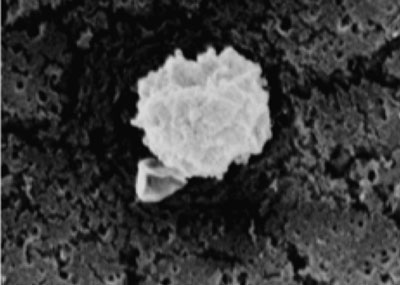| Nanotechnology is finding applications in the treatment of infectious and inflammatory diseases, particularly skin disease (see for instance: "Nitric oxide releasing nanoparticles for effective treatment of infections"). These applications work in one of two ways: utilizing nanomaterials that have inherent antimicrobial properties; or incorporating known therapeutics into nanoscale vehicles to enhance delivery and improve efficacy. | |
| "An ideal approach to develop a topical therapy for microbial infection in skin would combine both," Dr "Adam Friedman, Assistant Professor of Dermatology and Director of Dermatologic research at the Montefiore-Albert Einstein College of Medicine, tells Nanowerk. | |
| In new work, first-authored by Friedman, researchers at the Albert Einstein College of Medicine and University of California Los Angeles School of Medicine have developed a new nanoparticle platform using chitosan – a polysaccharide from the shells of crustaceans like crabs and shrimp – for the treatment of inflammatory skin diseases such as Acne Vulgaris. | |
| In their paper published in the Journal of Investigative Dermatology ("Antimicrobial and Anti-Inflammatory Activity of Chitosan–Alginate Nanoparticles: A Targeted Therapy for Cutaneous Pathogens"), the team demonstrate that not only were these nanoparticles effective at killingProprionobacterium acnes, the gram positive bacteria associated with acne, they inhibited the damaging inflammation that result in the large, painful lesions associated with inflammatory acne. | |
 | |
| Scanning electron microscopy, showing a chitosan-alginate nanoparticle measuring 226 nm after being exposed to water. (Image: Dr. Friedman, Albert Einstein College of Medicine) | |
| Acne is one of the most common dermatologic diseases affecting between 40-50 million people each year. While best known as bothersome part of puberty, affecting approximately 75% of teenagers, acne can persist or even first start during adulthood, causing emotional and physical distress as well as permanent disfigurement. | |
| Topical therapies for acne, including benzoyl peroxide, salicylic acid, topical antibiotics such as clindamycin, and retinoids all suffer from various related side effects including irritation, redness, peeling and scaling, bacterial resistance, and resulting discoloration from the associated irritation in patients of darker skin types. These adverse events often serve as major limiting factors influencing patient compliance and ultimately impacting efficacy. | |
| "Nanotechnology has tremendous potential in the field of dermatology for both cosmetic and medical applications," says Friedman. "In fact, there are a vast number of over-the-counter products utilizing nano-vehicles to more effectively deliver active agents for skin rejuvenation and sun protection. Along these lines, we encapsulated benzoyl peroxide in our chitosan-alginate nanoparticles for the purpose of improving both its activity and importantly, tolerability, as an anti-acne agent." | |
| He explains that, in order to synthesize nontoxic, biodegradable, and biocompatible nanoparticles (,< 50 nm) that can be used for the treatment of cutaneous infections, the team chose a derivative of the biostructural crustacean shell polymer chitin – chitosan – along with the well-known thermally stable gelling agent, alginate. | |
| The antimicrobial activity of chitosan is well-established and has been used as a preservative for food packaging to prevent spoilage. It has also been evaluated as a component for antimicrobial textiles used in clothing for health care workers. | |
| "We have found that the nanoparticles themselves have antimicrobial activity not only against P. acnes, but also against Methicillin Resistant Staphylococcus aureus and Escherichia coli, again highlighting the broad value of this platform," says Friedman. | |
| "Our paper demonstrates that chitosan-alginate nanoparticles can not only be utilized as a delivery tool but have inherent antimicrobial and anti-inflammatory properties which could be useful for other therapeutic applications," says Dr. Jenny Kim, Associate Professor of Dermatology, Chief of Dermatology at the Greater Los Angeles Healthcare System Veterans Affairs, and senior author of the paper. "This is an exciting finding with clinical relevance as development of novel therapeutics using chitosan-alginate nanoparticles could potentially be useful for the treatment of acne and other infectious and inflammatory skin diseases." | |
| By Michael Berger. Copyright Fonte: Nanowerk Spotlight |
